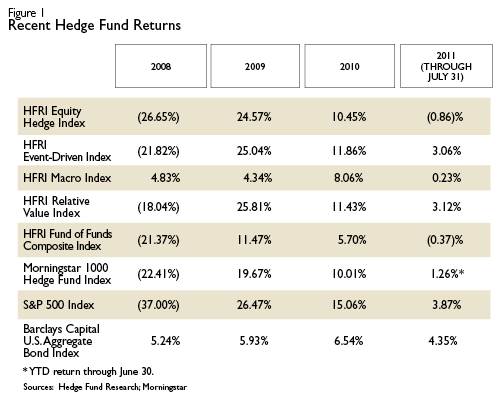Fresh Scenery
Despite these issues, advisors shouldn't dismiss hedge funds altogether. As of the end of June, the hedge fund industry was at peak assets-just over $2 trillion. New allocations to hedge funds exceeded $60 billion in the first half of 2011, higher than the total for all of 2010.
According to the 2011 Prequin Global Hedge Funds Investor Report, hedge fund investors were once primarily high-net-worth individuals. But the hedge fund landscape began to change after the 2008 financial crisis when individual investors, frustrated with the excessive fees and sagging performance of the overall hedge fund industry, moved out of the space and institutional investors began to dominate the asset class.
As more institutional money rushed into hedge funds, the balance of power between investors and fund managers began to shift. The leverage that institutional investors brought to the negotiating table allowed them to bargain for reduced fees and shorter lock-up periods, according to Prequin. The institutional investors who now rule the asset class favor bigger funds, in part because larger funds have better risk management and more compliance infrastructure, according to Prequin.
A recent Morningstar report confirms that the largest hedge funds are only growing larger. During the first quarter of 2011, the top 20 individual funds in Morningstar's database had 25% more in AUM than they did one year previously, while the next 20 largest funds managed only 10% more in assets over the prior year.
But perhaps the most significant post-crisis change in the hedge fund industry was investor demand for greater visibility, according to Kenneth J. Heinz, president of Chicago-based Hedge Fund Research. "The evolution of the industry, with regard to transparency, hit a key inflection point in December 2008, as a result of the disclosure of the financial fraud associated with Madoff Securities," he says.
Heinz thinks the industry has become a much better place to invest. "Managers are more responsive to investors in terms of due diligence," he says.

Finding Value
Alan Lenahan, director of Hedged Strategies for Cincinnati-based Fund Evaluation Group, an investment advisory firm, expects to see renewed and growing interest in hedge funds from high-net-worth investors, whether via single strategy funds or FoFs. Lenahan predicts "a sifting through of providers" where investors pick out higher-quality managers that came through 2008 and the last few years in better shape than their peers.
"There's been a lot of media negativity that has scared people," he says. Despite the bad press, Lenahan maintains that hedge funds are still a good way to provide diversification and stable returns, protect capital and reduce risk in a portfolio.
But finding the lonely star performers in the vast universe of hedge funds is not an easy task. Fund Evaluation Group devotes significant resources to doing just that. Yet few individual funds meet the firm's strict criteria for recommendation to its large clients, or for inclusion in its proprietary FoFs. Even funds that are top quartile performers throughout their lives will not pass muster unless they follow best practices across the board in terms of operational processes, financial controls and regulatory compliance. "There are 9,000 hedge funds," Lenahan says. "There are probably 200 or 300 that matter to us. There's an unbelievable amount of noise."
So how does an advisor who's considering putting clients' money into hedge funds, or FoFs, eliminate the "noise" and determine whether the potential rewards of investing in a particular fund or FoF outweigh the risks? The answer may well start with seeking out those funds and FoFs that attempt to align manager and investor interests. The first step in this process is what Lenahan calls "conviction," the expectation that if fund managers believe in their products, they will have a substantial portion of their own assets in the fund they're promoting.








